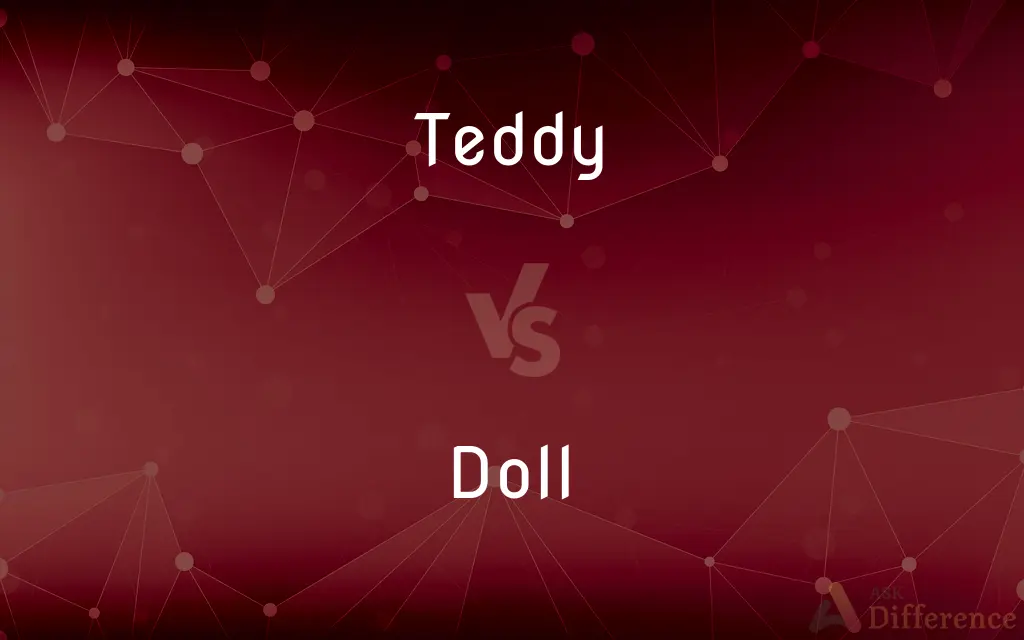Teddy vs. Doll — What's the Difference?
By Tayyaba Rehman & Urooj Arif — Updated on March 22, 2024
A teddy is a soft, plush toy bear, designed for cuddling, while a doll is a model of a human, often used for play by children or for collecting.

Difference Between Teddy and Doll
Table of Contents
ADVERTISEMENT
Key Differences
Teddy bears are crafted primarily from soft, plush materials, making them ideal for comfort and emotional support. These toys often resemble bears with exaggerated features such as large heads and small bodies, designed to invoke a sense of warmth and security. On the other hand, dolls are modeled to resemble humans or human-like characters, with features and proportions that can range from highly realistic to stylized or simplified. They may be made from a variety of materials, including plastic, cloth, or porcelain, and are used not only for play but also for display and collection purposes.
While teddies are typically associated with a universal design meant to be hugged and cherished, dolls are often equipped with movable parts such as arms, legs, and heads, allowing for a wider range of play and interaction. Dolls can come with accessories and clothes that can be changed, enhancing playtime with role-playing activities. In contrast, teddies are usually a one-piece design, focusing on simplicity and comfort.
The cultural significance of teddies and dolls varies widely. Teddy bears are often seen as symbols of childhood innocence and comfort, frequently gifted to express love or sympathy. Dolls, whereas, have been used throughout history not just as toys but as art pieces, teaching tools, and in rituals, reflecting a rich diversity of cultural practices and values.
In terms of collectibility, vintage and limited edition teddies can be highly sought after by collectors, prized for their craftsmanship, history, and rarity. Doll collectors, on the other hand, may focus on a wide range of attributes, including historical significance, manufacturer, condition, and rarity, with some collections emphasizing specific types such as fashion dolls, porcelain dolls, or character dolls from movies and comics.
Despite these differences, both teddies and dolls play significant roles in children's lives, offering opportunities for comfort, imaginative play, and emotional development. They serve as cherished possessions that can carry sentimental value well into adulthood.
ADVERTISEMENT
Comparison Chart
Material
Soft, plush fabrics
Plastic, cloth, porcelain
Design Focus
Comfort and cuddling
Human likeness, role play
Functionality
Primarily for comfort
Play, collectibility, display
Cultural Significance
Symbols of comfort
Varied cultural uses
Collectibility
Valued for craftsmanship and rarity
Valued for diversity, historical significance, and rarity
Compare with Definitions
Teddy
Collectible item.
The antique teddy from the 1920s was auctioned for a high price.
Doll
Cultural artifact.
Dolls in traditional attire were displayed at the cultural festival.
Teddy
A soft plush toy bear.
The child fell asleep clutching her teddy tightly.
Doll
Toy for role-playing.
With her dolls, she imagined being a teacher.
Teddy
Comfort object for all ages.
Even adults sometimes keep a teddy for nostalgic comfort.
Doll
Educational tool.
Parents use dolls to teach children about body parts and dressing.
Teddy
Emotional support toy.
Hospitals often give teddies to young patients for comfort.
Doll
Collectible item.
The porcelain doll collection was the envy of every enthusiast.
Teddy
Symbol of love and sympathy.
He gave her a teddy bear to express his affection.
Doll
A model of a human figure.
The child played house with her doll.
Teddy
Teddy is an English language masculine given name: usually a familiar or nickname form of Edward or Theodore.
Doll
A doll is a model typically of a human or humanoid character, traditionally used as a toy for young girls. Dolls have also been used in religious rituals throughout the world.
Teddy
A woman's undergarment combining a camisole top and panties.
Doll
A small model of a human figure, typically one of a baby or girl, used as a child's toy.
Teddy
A teddy bear.
Doll
A temporary barrier on a racecourse or gallop.
Teddy
Abbreviation of teddy bear
Doll
Dress someone smartly and attractively
I got all dolled up for a party
Teddy
(by extension) Any stuffed toy. en
Doll
Place a barrier in front of (a jump or other part of the course that is to be omitted from a race)
Staff incorrectly dolled off a fence at the meeting
Teddy
A type of all-in-one women's undergarment.
Doll
A figure having the likeness of a human, especially one used as a child's toy.
Teddy
Plaything consisting of a child's toy bear (usually plush and stuffed with soft materials)
Doll
A person considered to be physically attractive.
Teddy
A woman's sleeveless undergarment
Doll
A woman.
Doll
A helpful or obliging person
What a doll you've been in this crisis!.
Doll
Used as a term of endearment.
Doll
A toy in the form of a human.
Action figure
Doll
(slang) An attractive young woman.
Doll
A term of endearment: darling, sweetheart.
Doll
A good-natured, cooperative or helpful girl.
Doll
The smallest or pet pig in a litter.
Doll
A kind of barrier used in horse racing.
Doll
(rail) A short signal post mounted on a bracket mounted on the main signal post, or on a signal gantry.
Doll
A dollar.
Doll
A small, usually flexible figure representing a human being, especially a toy baby for a little girl; a child's puppet.
Doll
An attractive woman or girl.
Come along and be my party doll.
Doll
A small replica of a person; used as a toy
Doll
Informal terms for a (young) woman
Common Curiosities
Can dolls have educational purposes?
Yes, dolls can serve as educational tools in various contexts.
Are dolls only made from plastic?
No, dolls can be made from plastic, cloth, porcelain, and other materials.
Do teddies have movable parts?
Typically, teddies do not have movable parts; they are designed for cuddling.
Can dolls be used in therapeutic settings?
Yes, dolls are used in therapeutic settings for role-playing and teaching social skills.
How do collectors determine the value of a doll?
The value is based on rarity, condition, manufacturer, and historical significance.
Can teddies be considered collectibles?
Yes, vintage and limited edition teddies are highly collectible.
Are all dolls intended for children?
No, many dolls are designed for collectors and may not be suitable for children.
Do teddy bears only come in the shape of bears?
While traditional teddies resemble bears, there are variations that may take inspiration from other animals.
Can dolls be custom-made?
Yes, there are many artists and companies that offer custom-made dolls.
Are there teddies made for outdoor use?
Generally, teddies are designed for indoor use, though some are made with durable materials for outdoor activities.
Is it common for adults to collect teddies?
Yes, many adults collect teddies for their nostalgic value and as a hobby.
Do all dolls come with accessories?
Many dolls come with accessories, but it varies by type and brand.
Can teddies be washed?
Yes, many teddies are designed to be washable, though care instructions vary.
Are there teddies designed specifically for holidays?
Yes, holiday-themed teddies are popular gifts for occasions like Valentine's Day and Christmas.
How do teddies help in emotional development?
Teddies can provide comfort and a sense of security, aiding in emotional regulation.
Share Your Discovery

Previous Comparison
Rest vs. Wrest
Next Comparison
Disconfirm vs. ConfirmAuthor Spotlight
Written by
Tayyaba RehmanTayyaba Rehman is a distinguished writer, currently serving as a primary contributor to askdifference.com. As a researcher in semantics and etymology, Tayyaba's passion for the complexity of languages and their distinctions has found a perfect home on the platform. Tayyaba delves into the intricacies of language, distinguishing between commonly confused words and phrases, thereby providing clarity for readers worldwide.
Co-written by
Urooj ArifUrooj is a skilled content writer at Ask Difference, known for her exceptional ability to simplify complex topics into engaging and informative content. With a passion for research and a flair for clear, concise writing, she consistently delivers articles that resonate with our diverse audience.














































